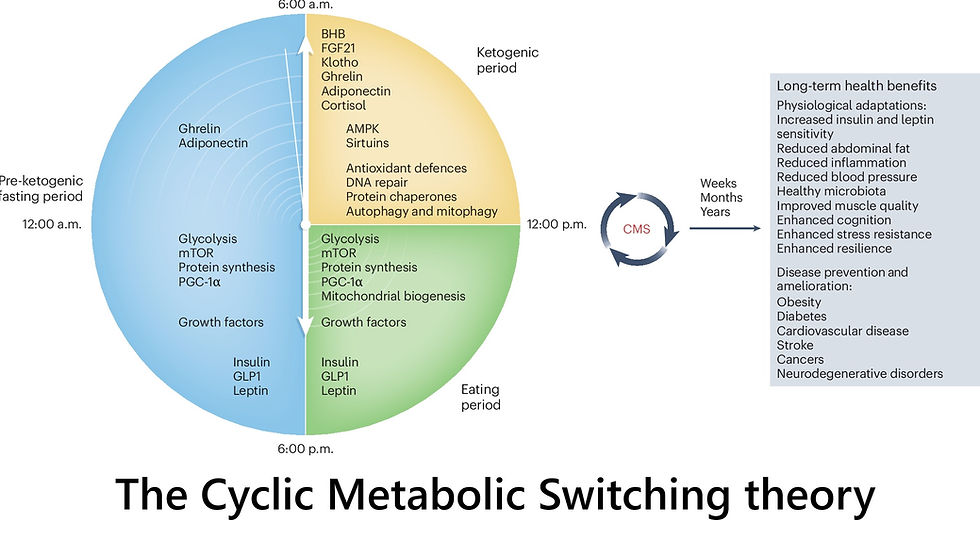The Metabolic Ceiling: Discovering the Body’s Speed Limit for Endurance and Resilience
- Healing_ Passion
- 12 minutes ago
- 3 min read
How much energy can a human truly sustain?
Not for a sprint, not for a day—but for months on end?
A new study published in Current Biology (Best et al., 2025) finally puts numbers on this question, revealing what might be called the bioenergetic speed limit of human endurance. And surprisingly, it’s not our muscles that set the limit—it’s our metabolism’s rhythm.
What the researchers did
Fourteen elite ultra-endurance athletes—ultramarathoners, triathletes, and a long-distance cyclist—volunteered for an experiment that tracked how their bodies spent energy over time.
To measure energy output precisely, the scientists used the doubly labeled water technique—a gold-standard method that tags the body’s water with harmless isotopes to trace how much carbon dioxide is produced each day. This allows calculation of total energy expenditure (TEE) with remarkable accuracy, even during races lasting from a single day up to nearly two weeks.
Then the team reconstructed each athlete’s metabolic scope (MS)—the ratio of total energy output to basal metabolic rate (BMR)—across time windows from 1 week to an entire year using their training logs and individualized models. The question: Does human energy expenditure follow a predictable ceiling that declines with duration?
What they found
Yes. The results were beautifully rhythmic:
For one-day ultra events, total energy output peaked near 10× basal metabolism—an explosive “respond” phase.
Over weeks, this intensity fell in a logarithmic curve toward a stable ceiling of around 2.5× BMR, a sustainable long-term rhythm.
Even the most extreme athletes—running 6,000+ km a year—rarely exceeded this limit.
A few briefly reached 2.7× BMR, but none could hold higher for long.
In essence, the longer the effort, the lower the sustainable metabolic tempo.
Beyond this ceiling, something else must give way.
The hidden trade-off
As energy demand rose, the body silently rebalanced its books.
Non-exercise energy use—walking, fidgeting, thermoregulating, even reproductive hormone activity—plummeted. During races, these functions nearly shut down.
It was a vivid display of bioenergetic triage: when survival performance dominates, maintenance and renewal must wait. The athletes’ physiology shifted to pure endurance mode—proof that energy allocation is a zero-sum game.
How this aligns with the ERM and CACH frameworks
In the Exposure-Related Malnutrition (ERM) framework, health and disease are viewed through the lens of energy availability and allocation. The body constantly cycles through three phases—Respond, Adapt, and Recover—much like a pendulum of resilience.
Respond: Mobilize energy fast to face a challenge.
Adapt: Rebalance and sustain effort through internal redistribution.
Recover: Rebuild, replenish, and reset the tempo.
Best and colleagues’ data show that even elite athletes cannot escape this rhythm. Push the “respond” phase too long without allowing recovery, and the system begins to borrow—entering bioenergetic debt, the earliest stage of exhaustion that ERM identifies as Exposure-Related Malnutrition.
This finding also echoes the CACH hypothesis (Catabolic–Anabolic Cycling of Hormesis): adaptation depends on oscillating between catabolic breakdown and anabolic repair. The ultra-endurance athlete’s year is a living example of this dance—high-tempo catabolic surges balanced by slower anabolic restoration.
Why rhythm matters more than power
These athletes prove that resilience isn’t about infinite energy—it’s about keeping time with your biology.
Every system in the body, from mitochondria to hormones, operates in rhythm: stress and rest, use and repair, catabolism and anabolism. When this rhythm is honored, energy flows efficiently. When it’s ignored, even the strongest body begins to crumble.
Whether we are athletes, office workers, or caregivers, our health depends on the same law: you cannot run faster than your own metabolism can recover.
The takeaway
The “metabolic ceiling” is not a limit to fear—it’s a compass for balance.
It tells us that endurance, performance, and longevity all rely on respecting the tempo of life: respond fully, adapt wisely, and recover deeply.
This is the same rhythm that builds resilience—and the rhythm the ERM framework helps us restore.
Reference:
Best A, Sadhir S, Hyatt E, Pontzer H. Ultra-endurance athletes and the metabolic ceiling. Current Biology. 2025;35:5106–5110. doi:10.1016/j.cub.2025.08.063





Comments